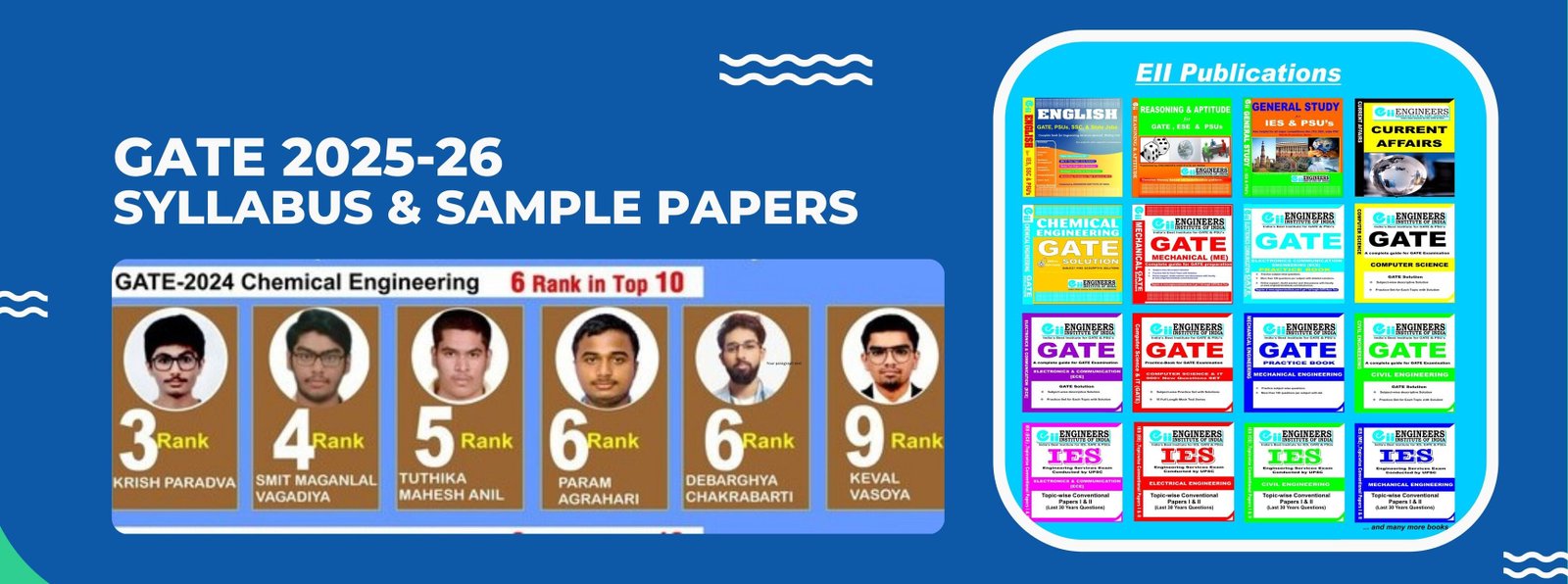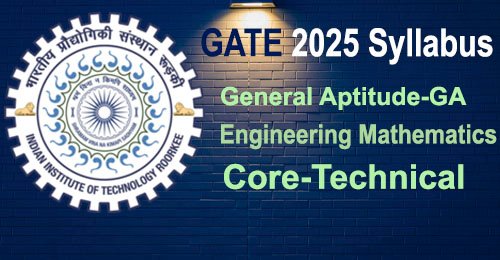GATE2025 Electrical Engineering- EE Syllabus
Important Note for Candidates: In each of the following subjects the topics have been divided into two categories – Core Topics and Special Topics. The corresponding sections of the question paper will contain 90% of their questions on Core Topics and the remaining 10% on Special Topics.
Section 1: General Aptitude (GA) Syllabus
(Common for all, 10 Question, 15 Marks)
The General Aptitude section is a common component across all papers of the GATE 2025 examination, constituting 15 marks out of 100 for each subject. The syllabus, available on the official website, aids candidates in preparing more effectively for the GATE 2025 exam. The GATE General Aptitude (GA) Syllabus comprises four key sections:
- 1. Quantitative Aptitude
- 2. Verbal Aptitude
- 3. Analytical Aptitude
- 4. Spatial Aptitude
1. Quantitative Aptitude in the General Aptitude (GA) Syllabus covers the following topics:
- Numerical computation and estimation
- Ratios
- Percentages
- Powers
- Exponents and logarithms
- Permutations and combinations
- Series
- Mensuration and Geometry
- Elementary statistics
- Probability
2. Verbal Aptitude in General Aptitude (GA) Syllabus includes the following topics:
| Basic English Grammar | Basic Vocabulary |
|---|---|
| Tenses | Words |
| Articles | Idioms and phrases |
| Prepositions | |
| Conjunctions | |
| Adjectives | |
| Verb-Noun agreement |
3. Analytical Aptitude in the General Aptitude (GA) Syllabus includes the following topics:
- • Logic: deduction and induction
- • Analogy
- • Numerical relations and reasoning
4. Spatial Aptitude in the General Aptitude (GA) Syllabus includes the following topics:
- • Transformation of shapes
- • Translation & Rotation
- • Scaling & Mirroring
- • Assembling & Grouping
- • Cutting & Paper folding pattern
- • Patterns in 2 and 3 dimensions
Section 2A: Engineering Mathematics
Linear Algebra: Matrix algebra, Systems of linear equations, Eigen values and eigenvectors.
Calculus: Functions of single variable, Limit, continuity and differentiability, Taylor series, Mean value theorems, Evaluation of definite and improper integrals, Partial derivatives, Total derivative, Maxima and minima, Gradient, Divergence and Curl, Vector identities, Directional derivatives, Line, Surface and Volume integrals, Stokes, Gauss and Green’s theorems.
Differential Equations: First-order equations (linear and nonlinear), Higher-order linear differential equations with constant coefficients, Method of variation of parameters, Cauchy’s equation, Euler’s equation, Initial and boundary value problems, Partial Differential Equations, Method of separation of variables.
Complex Variables: Analytic functions, Cauchy’s integral theorem, Cauchy’s integral formula, Taylor series, Laurent series, Residue theorem, Solution integrals.
Probability and Statistics: Sampling theorems, Conditional probability, Mean, Median, Mode, Standard Deviation, Random variables, Discrete and Continuous distributions, Poisson distribution, Normal distribution, Binomial distribution, Correlation analysis, Regression analysis.
Section 2B Core Subjects : Electric circuits
Atmosphere: Properties, standard atmosphere. Classification of aircraft. Airplane (fixed-wing aircraft) configuration and various parts. Pressure altitude; equivalent, calibrated, indicated speeds; Primary flight instruments: Altimeter, ASI, VSI, Turn-bank indicator. Angle of attack, sideslip; Roll, pitch & yaw controls. Aerodynamic forces and moments.
Airplane Performance: Drag polar; take-off and landing; steady climb and descent; absolute and service ceiling; range and endurance, load factor, turning flight, V-n diagram. Winds: head, tail and crosswinds.
Static Stability: Stability and control derivatives; longitudinal stick fixed and free stability; horizontal tail position and size; directional stability, vertical tail position and size; lateral stability. Wing dihedral, sweep & position; hinge moments, stick forces.
Special Topics: Dynamic stability: Euler angles; Equations of motion; Decoupling of longitudinal and lateral-directional dynamics; longitudinal modes; lateral-directional modes.
Section 2C Core Subjects : SPACE DYNAMICS
Network Elements: Ideal voltage and current sources, dependent sources, R, L, C, M elements; Network solution methods: KCL, KVL, Node and Mesh analysis; Network Theorems: Thevenin’s, Norton’s, Superposition and Maximum Power Transfer theorem; Transient response of DC and AC networks, sinusoidal steady-state analysis, resonance, two-port networks, balanced three-phase circuits, star-delta transformation, complex power and power factor in AC circuits.
Electromagnetic Fields: Coulomb's Law, Electric Field Intensity, Electric Flux Density, Gauss's Law, Divergence, Electric field and potential due to point, line, plane and spherical charge distributions, Effect of dielectric medium, Capacitance of simple configurations, Biot‐Savart’s law, Ampere’s law, Curl, Faraday’s law, Lorentz force, Inductance, Magnetomotive force, Reluctance, Magnetic circuits, Self and Mutual inductance of simple configurations.
Signals and Systems: Representation of continuous and discrete-time signals, shifting and scaling properties, linear time-invariant and causal systems, Fourier series representation of continuous and discrete-time periodic signals, sampling theorem, Applications of Fourier Transform for continuous and discrete-time signals, Laplace Transform and Z transform. R.M.S. value, average value calculation for any general periodic waveform.
Electrical Machines: Single-phase transformer: equivalent circuit, phasor diagram, open circuit and short circuit tests, regulation and efficiency; Three-phase transformers: connections, vector groups, parallel operation; Auto-transformer, Electromechanical energy conversion principles; DC machines: separately excited, series and shunt, motoring and generating mode of operation and their characteristics, speed control of DC motors; Three-phase induction machines: principle of operation, types, performance, torque-speed characteristics, no-load and blocked-rotor tests, equivalent circuit, starting and speed control; Operating principle of single-phase induction motors; Synchronous machines: cylindrical and salient pole machines, performance and characteristics, regulation and parallel operation of generators, starting of synchronous motors; Types of losses and efficiency calculations of electric machines.
Power Systems: Basic concepts of electrical power generation, AC and DC transmission concepts, Models and performance of transmission lines and cables, Economic Load Dispatch (with and without considering transmission losses), Series and shunt compensation, Electric field distribution and insulators, Distribution systems, Per‐unit quantities, Bus admittance matrix, Gauss-Seidel and Newton-Raphson load flow methods, Voltage and Frequency control, Power factor correction, Symmetrical components, Symmetrical and unsymmetrical fault analysis, Principles of over‐current, differential, directional and distance protection; Circuit breakers, System stability concepts, Equal area criterion.
Control Systems: Mathematical modeling and representation of systems, Feedback principle, transfer function, Block diagrams and Signal flow graphs, Transient and Steady‐state analysis of linear time invariant systems, Stability analysis using Routh-Hurwitz and Nyquist criteria, Bode plots, Root loci, Lag, Lead and Lead‐Lag compensators; P, PI and PID controllers; State space model, Solution of state equations of LTI systems.
Electrical and Electronic Measurements: Bridges and Potentiometers, Measurement of voltage, current, power, energy and power factor; Instrument transformers, Digital voltmeters and multi-meters, Phase, Time and Frequency measurement; Oscilloscopes, Error analysis.
Analog and Digital Electronics: Simple diode circuits: clipping, clamping, rectifiers; Amplifiers: biasing, equivalent circuit and frequency response; oscillators and feedback amplifiers; operational amplifiers: characteristics and applications; single-stage active filters, Active Filters: Sallen Key, Butterworth, VCOs and timers, combinatorial and sequential logic circuits, multiplexers, demultiplexers, Schmitt triggers, sample and hold circuits, A/D and D/A converters.
Power Electronics: Static V-I characteristics and firing/gating circuits for Thyristor, MOSFET, IGBT; DC to DC conversion: Buck, Boost and Buck-Boost Converters; Single and three-phase configuration of uncontrolled rectifiers; Voltage and Current commutated Thyristor-based converters; Bidirectional AC to DC voltage source converters; Magnitude and Phase of line current harmonics for uncontrolled and thyristor-based converters; Power factor and Distortion Factor of AC to DC converters; Single-phase and three-phase voltage and current source inverters, sinusoidal pulse width modulation.


